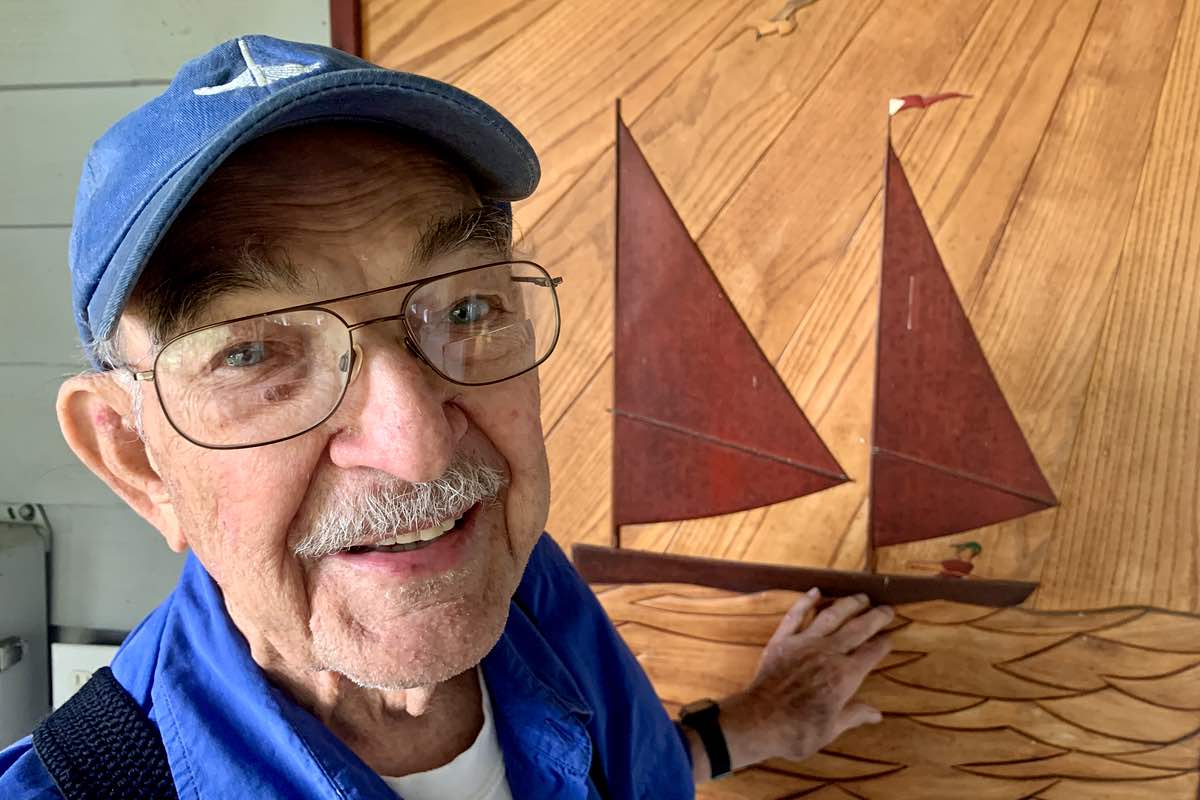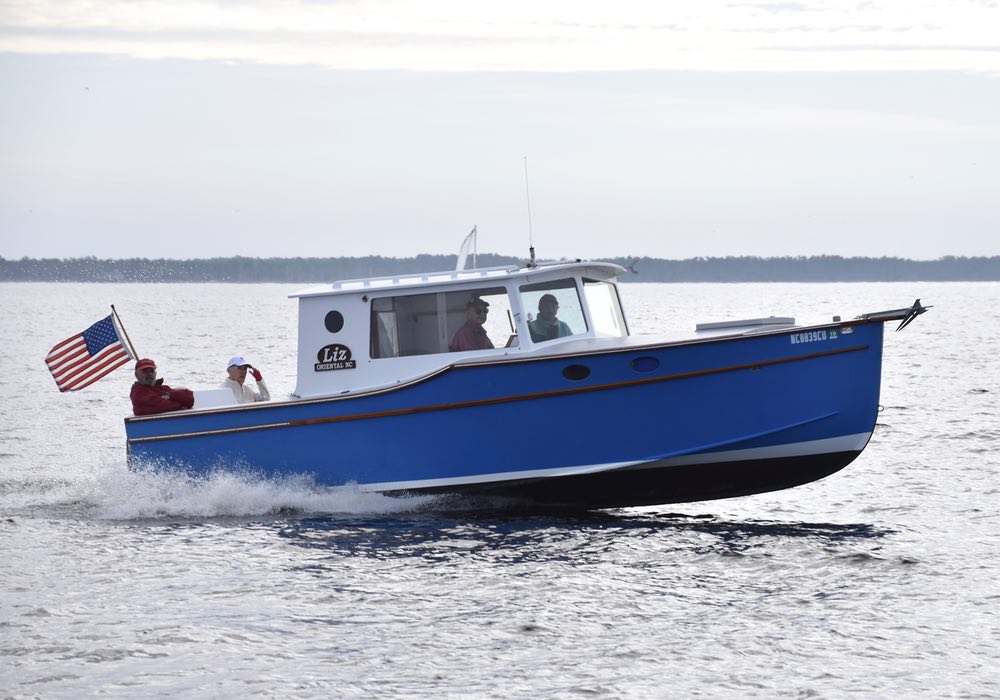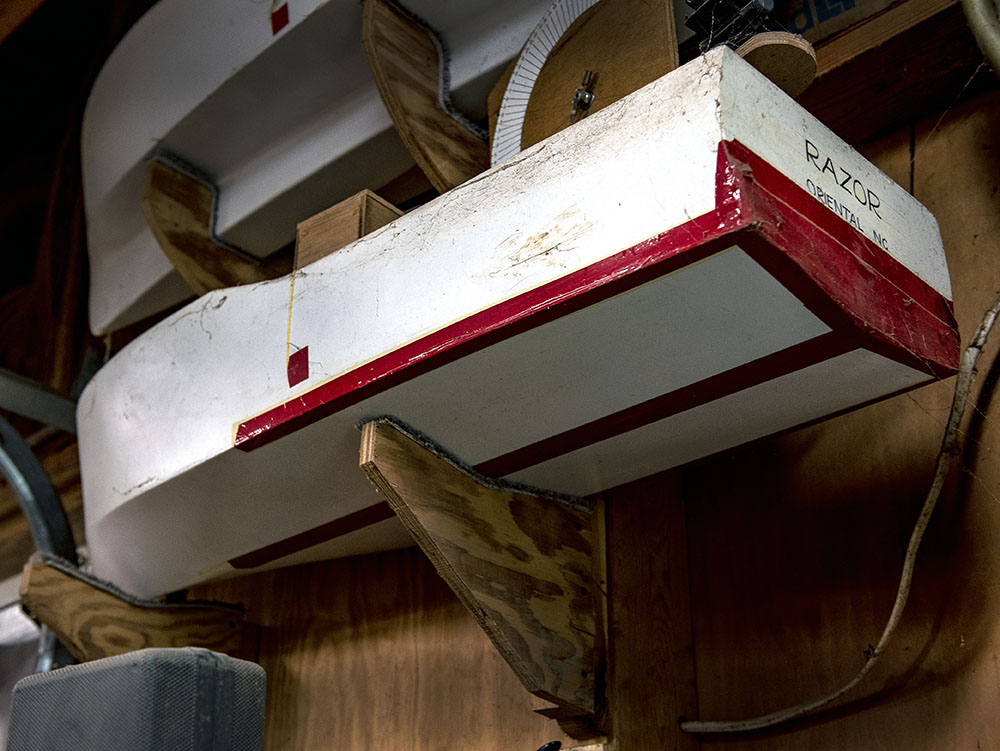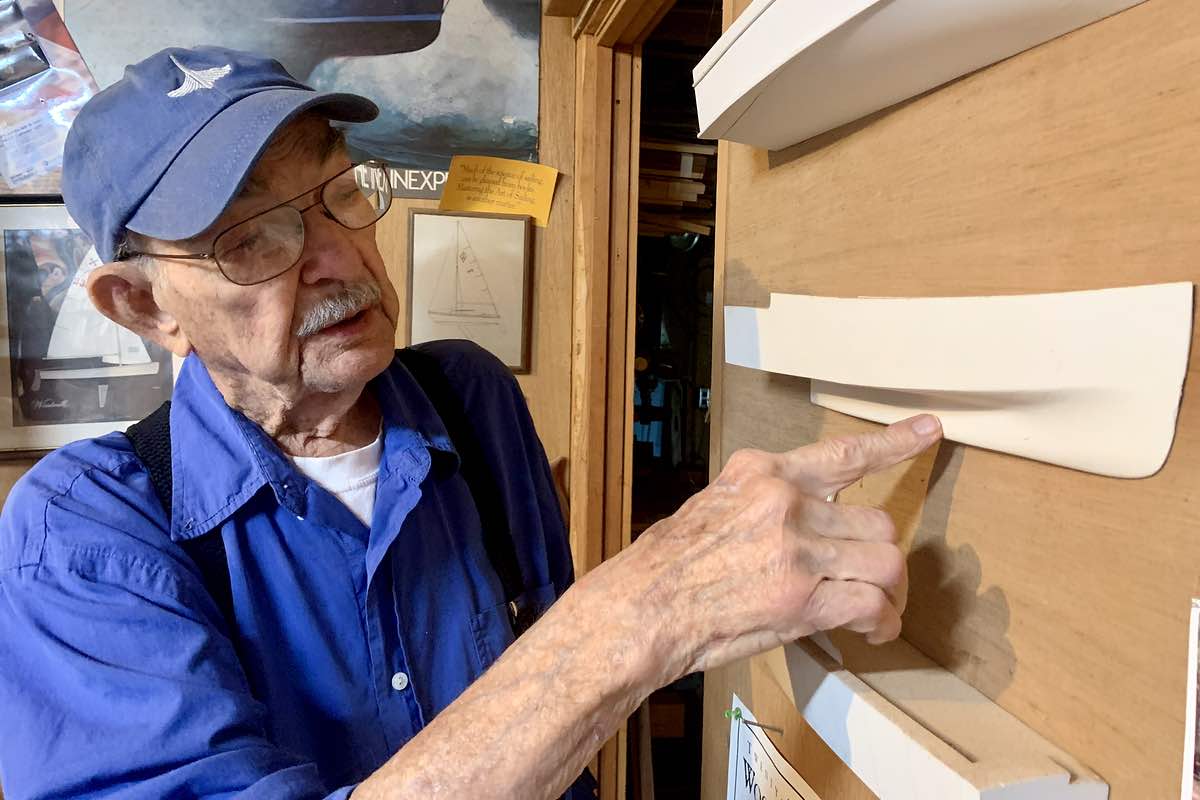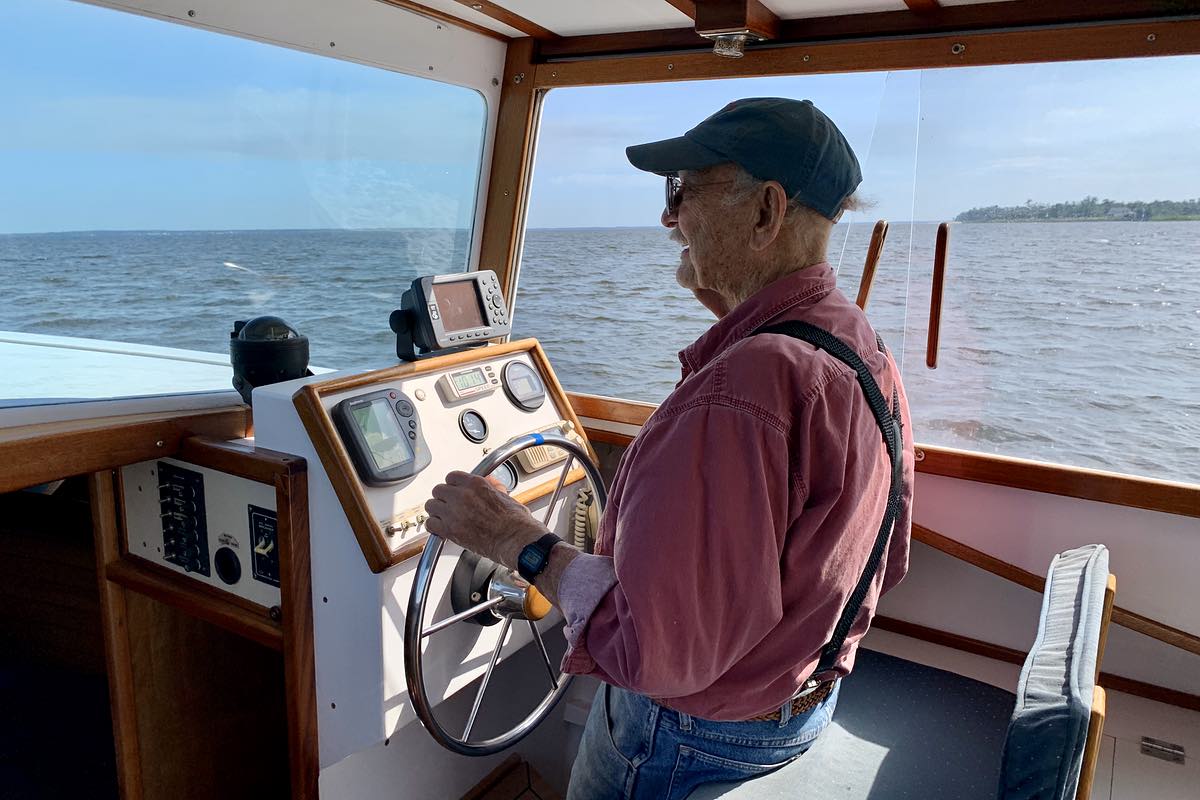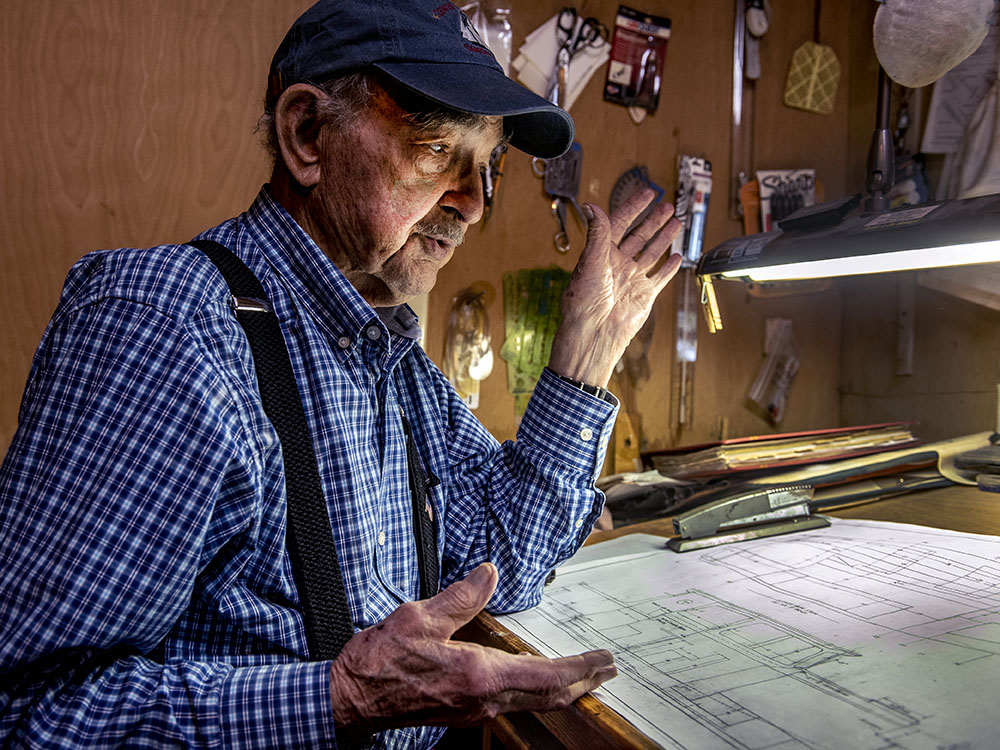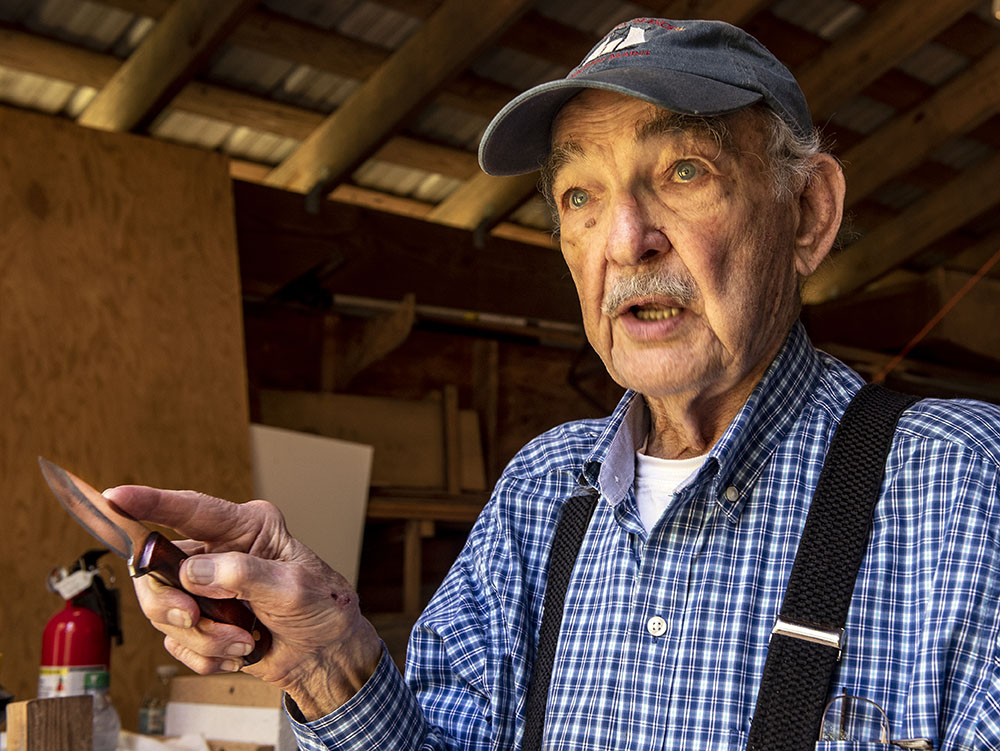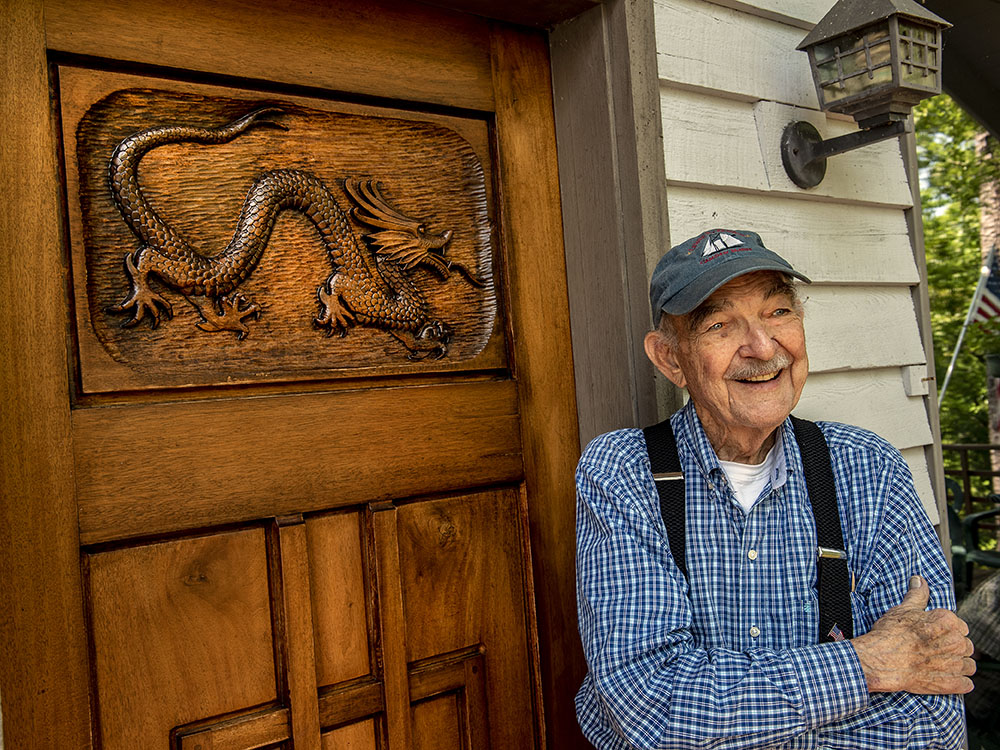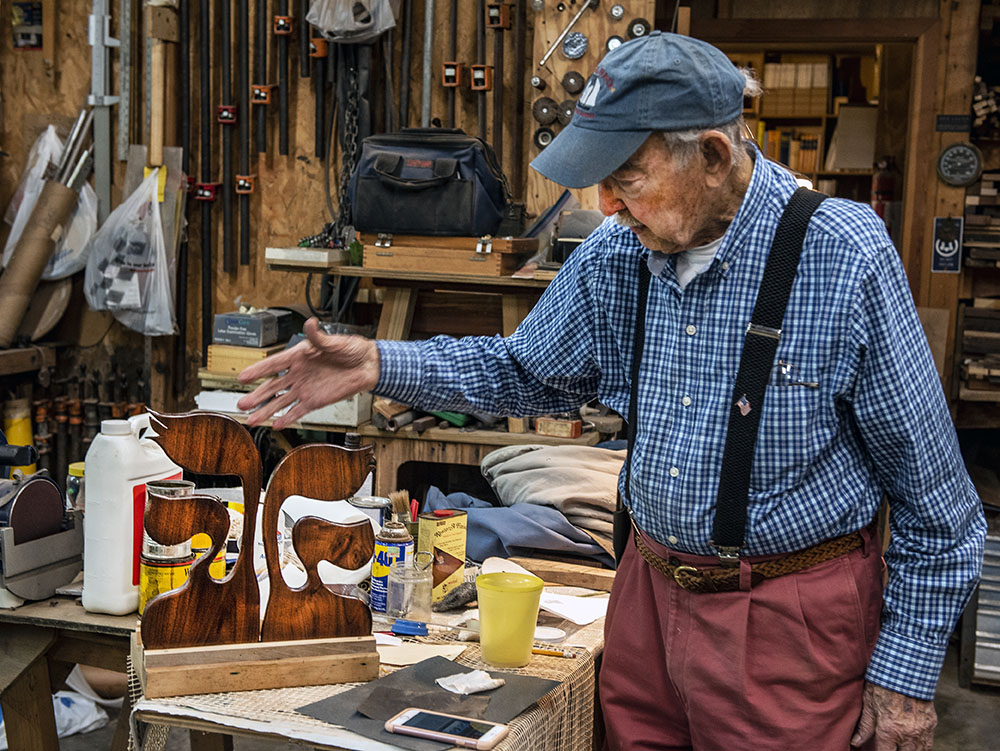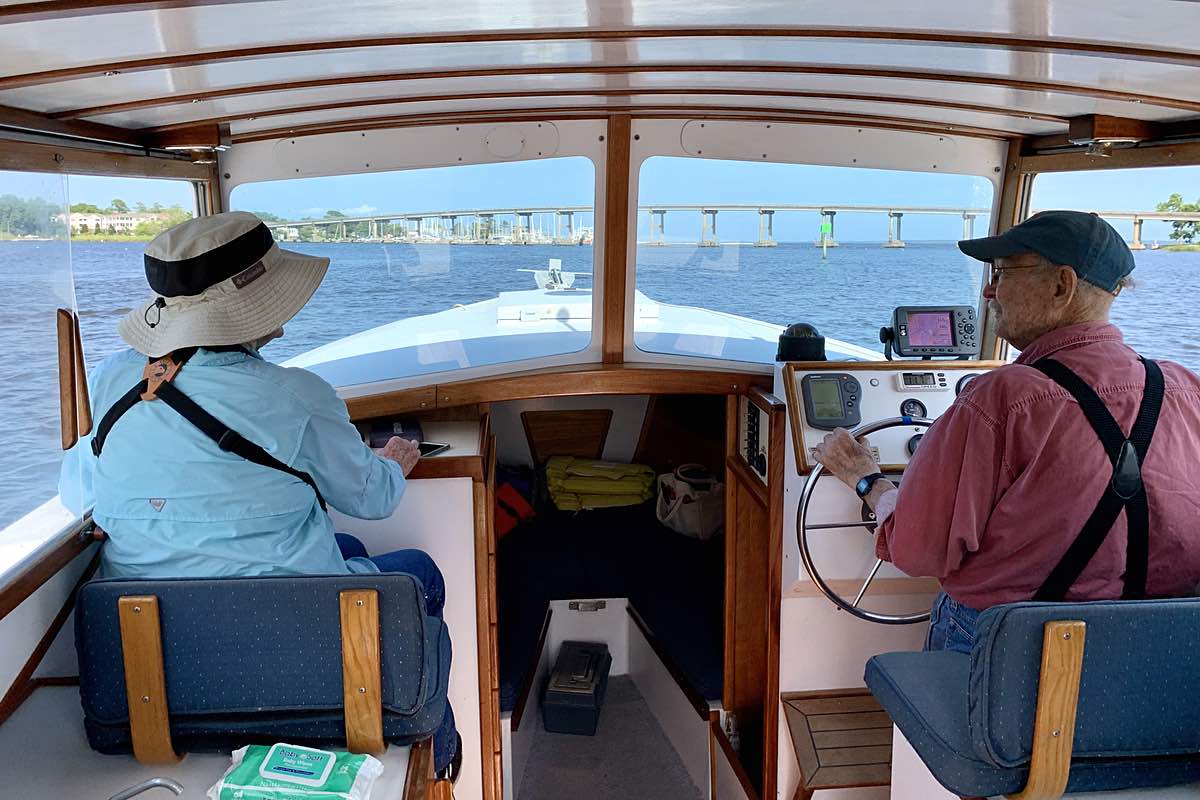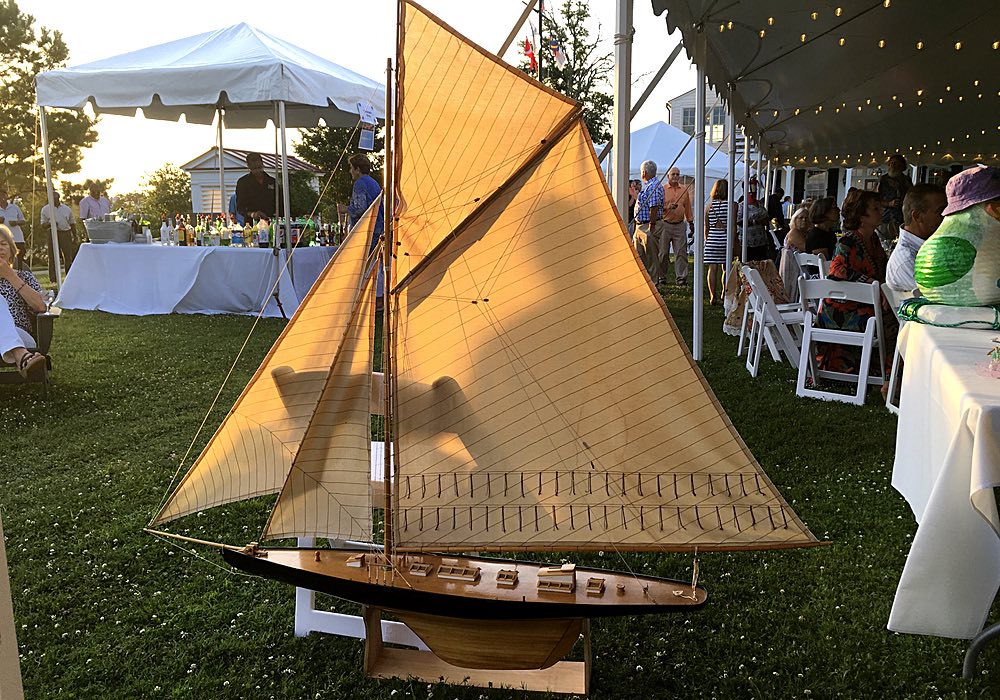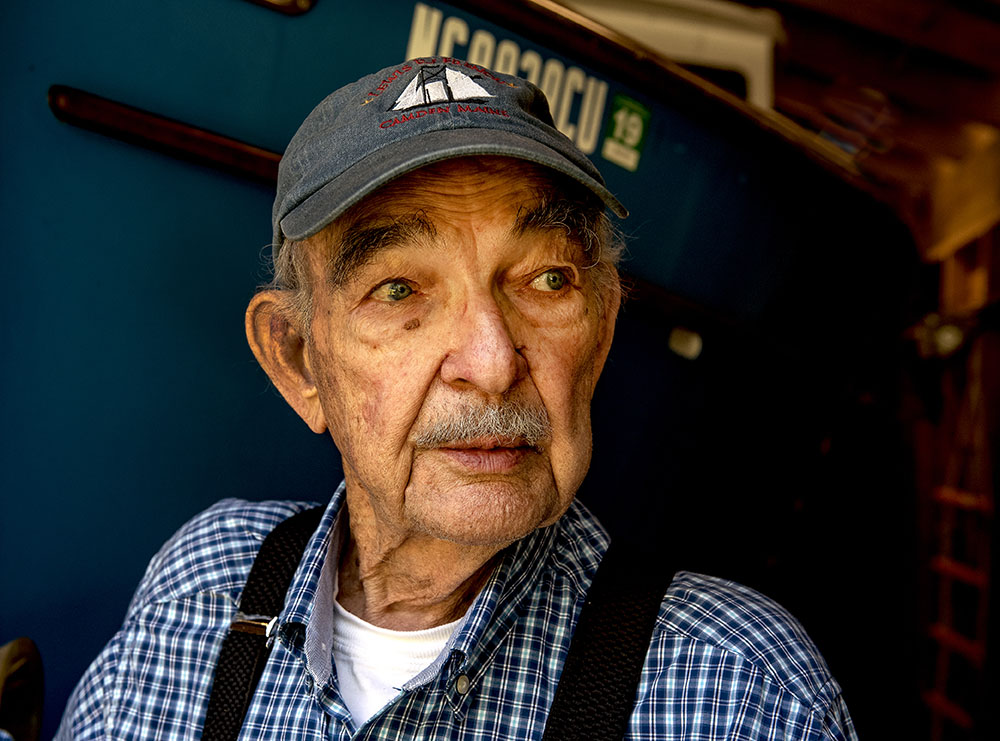It's Sunday January 18, 2026
September 17, 2021
He served in the Navy. He married Liz, the love of his life, and then got a degree in Science and Engineering. While working at Bell Labs, he designed communication systems to reach submarines. With Liz, he raised two sons. He’s built multiple homes. In his 60s, he learned yacht design and went ahead and built multiple boats.Meet Tom Lathrop. Today he turns 90.
Tom Lathrop and one of his many wood carvings.When most people reach their late 60s, they slow down. Not Tom. He designed and built a 24’ boat.
Tom’s own design, the BlueJacket 24 Liz, named after his wife.Everywhere she goes, Tom Lathrop’s Bluejacket 24 motor yacht turns heads.
The wood hulled cruiser is admired for her crisp lines, her smooth, level passage through the water, and her classic simplicity. But the Bluejacket’s beauty is more than hull deep. To learn more about her unique qualities is to discover a great deal about the man who designed and built her.
“I’m totally unimpressed by the new design of boats that look like Nike running shoes,” Tom says, “just so they can show off a big interior.” Although he and Liz, his wife of 64 years, had always been sailors, cruising up and down the waterway from Maine to Key West, Tom says, “the ICW at 6 knots in a sailboat can be boring.” He wanted a small cruising powerboat capable of handling a wide range of conditions, but finding the right powerboat proved elusive.
On a trip to Alaska with Liz in 1979, they stopped by Sam Devlin’s boat works in Olympia, Washington. Devlin’s beautiful wood powerboats appealed to Tom, but “they didn’t do quite what I wanted them to do.” For one thing, he felt they were too heavy and required too much power to perform at speed. Failing to find a boat that met his standards, Tom decided to design his own. “I didn’t know anything about designing powerboats,” he admits, but for a man who loves an engineering challenge, this was no obstacle.
Boat models adorn the walls in Tom’s workshop.The conventional approach to powerboat design dictates that the heavier the boat, the more power it needs to plane, and while planing boats run well at high speeds, Tom feels they tend to behave poorly until they reach at least 16 – 20 knots. “Until then, the bow is in the air, the stern is down, the boat throws a big wake, and it uses a lot of fuel,” he explains. Putting his engineering expertise to work, he adopted a fundamental principle of racing sailboats, where weight is the name of the game. He wanted a lightweight boat that would run between 10 and 20 knots economically, safely, and comfortably.
Equally important, Tom wanted a boat that was trailerable. For years, he and Liz owned a Catalina 22, but chafed at its limitations. “Whenever we wanted to go somewhere, we always had to make sure we could get back. We seldom went to Ocracoke because folks who go on a Saturday are never sure they can get back on Sunday. But at 50 mph on the highway, you can go a long way!”
Using a model he built, Tom explains naval architecture.Tom started sketching plans for a 24’ boat and tested his ideas using a 4’ model he built on a scale ratio of 6:1. Using the mast from a Sailfish as a boom, he attached one end to the model and the other to the beam of his 15’ skiff. He then towed the model alongside the skiff where its performance wasn’t impacted by the skiff’s wake. A towline threaded through turning blocks led to a device he fashioned from his wife’s postal scale, allowing him to measure the resistance, or drag, of the model. Once satisfied with a model that performed as expected, Tom began building a full-sized Bluejacket 24.
Constructed in a stitch and glue method from marine quality plywood, fiberglass, and epoxy, the boat would be strong and rigid. The cabin, cockpit sole and interior berths are bonded to the hull, increasing its structural integrity. Bluejacket’s cruising displacement, fitted with a 50 hp Yamaha four-stroke motor and fully loaded with water, fuel, stores, and a two-person crew, is just over 2800 pounds – far less than most powerboats of similar size. Local boatbuilders told Tom his boat would need more power or it would never plane. Tom proved them wrong. “It works beautifully on 50 hp,” he says, “it doesn’t need any more.” Cruising between 12 and 14 mph and topping out at 23 mph, she maintains a constant trim angle even when slowing to 7 or 8 mph. She’s also capable of handling the rough waters found in most inland cruising grounds. Tom once navigated across open water in a 35 knot northeaster, “although I would not choose to do so again,” he concedes.
Tom Lathrop at the helm of MV Liz.The Bluejacket 24s creature comforts are carefully considered. The main cabin had to have sitting headroom for a 6’ person “with a cap on,” and full standing headroom at the steering station and in the pilot house. A comfortable crew seat positioned to provide a good view forward was essential. A private, stand-up head was another must-have. For cooking, Tom fashioned a special box containing a two-burner propane stove fitted with a regulator attached to a 17-ounce propane bottle. “The great thing is that we don’t like to cook inside and smell up the boat. We can take the stove and cook outside.” Meticulously handcrafted drawers contain utensils, pots, and pans. “It’s minimal,” he says, “but it’s all we wanted.”
Tom launched the Bluejacket 24 in May of 2000. All that was left was to christen her, and there was only one name that would do, but first Tom had to overcome his wife’s resistance. In the end, Liz relented, and the boat became her namesake. “Liz is worth anything I can do for her,” he says softly. Since then, the couple has cruised “Liz” throughout the coastal sounds of North Carolina, South Carolina, the Chesapeake Bay, and as far away as the Trent Severn Waterway, the North Channel, and Georgian Bay in Ontario, Canada.
Tom sits at his drafting table, over the Bluejacket design plans.Eventually, Tom wrote an article about “Liz” for Boat Builder Magazine. The article caught the eye of Ted Brewer, who encouraged Tom to market Bluejacket 24 plans. Despite having designed and built “Liz”, Tom had no formal plans drawn, so he went to work drafting blueprints by hand. Today, avid boat builders from as far away as Australia and New Zealand have bought Tom’s plans, built their own boat, and are cruising distant waters. Some have requested modifications, so Tom designed a Bluejacket 28, 25.5, and a 27. Each retains the impressive performance of the original 24. “That’s how the plans came about,” Tom says, “and each boat after the 24 was like duck soup because it was just modifications of the same thing.” Nevertheless, it’s pretty cool to know his boats are being sailed all around the world. “Very cool” he agrees. “I feel very fortunate to have done something that is appreciated to that degree.”
Tom’s path to designing a boat that has been built and cruised by fans around the world was not a conventional one. In 1948, at the age of 17, he left high school, and with his father’s permission, joined the Navy. “I did poorly in school,” he admits, “but I was an avid reader. I’d hide out in the library reading how-to magazines when I was supposed to be studying.” He had never taken a course in algebra, geometry, or trigonometry, yet on the aptitude test given to new sailors, Tom earned the highest scores in his company. The Navy, recognizing Tom’s innate talent, enrolled him in electronics training before sending his ship to Korea.
Not only boats, but handles, too. Tom made the knife he is holding.When he finished his tour of duty, Tom had newfound appreciation for education and in 1959, earned a Bachelor of Science degree in Electrical Engineering from the University of South Carolina. Between his sophomore and junior year at USC, he found time to marry Liz Miller, the woman who would become the love of his life.
Tom was hired by prestigious Bell Labs straight out of university and a few years later the company offered him the opportunity to pursue a master’s degree. He seized the chance. He and Liz moved to Raleigh where Tom earned his advanced degree at NC State in 1964. While at Bell Labs, he worked on a wide range of projects, many of which were aimed at helping the U.S military detect enemy submarine activity. His achievements included designing and helping to build an underwater communications system linking military control stations with strategic antiballistic launch sites in the Pacific.
Standing in front of another of his wood works.Later, working for Western Electric, he designed an instrument that would be used by the AT&T telephone network to identify the direction of subterranean currents and pinpoint interruptions that may have been caused by a critter chewing through an underground electrical line or cut by accidental digging. “I’m one of the very few people in the world who has studied the earth’s currents,” he explains. Although Tom holds the patent for this invention, as an employee of Western Electric, he was paid only one dollar. “I still have that dollar in a frame,” he says.
Meanwhile, life was speeding up for the Lathrops. Sons Mark and Tim had been born, and Tom began to rekindle his interest in sailing. He ordered a Windmill, a 15 ½ foot racing sailboat built in Winston-Salem, which he and Liz enjoyed sharing with their young family. But Tom felt he could improve on the boat’s performance. He adapted the basic Windmill plan for composite construction and built a version that was lighter and faster. Years later, he would have the satisfaction of watching Windmills built according to his modified plans finish first, second, and third in the National Windmill Championship race on Chesapeake Bay. The victory was even sweeter because the first-place boat had been built by Tom and sailed by his son, Mark. “He’s a better sailor than I am,” Tom is proud to say – although Mark explains, “I had an earlier start.”
Tom is always building something in his workshop.Tom’s interest in building things was gaining momentum. In 1981 he and several others formed The Wood Workers Guild of Georgia, attracting some of the best woodworkers in the country. “To be a part of this group,” Tom says, “you had to do good stuff. You were expected to bring something new to every meeting, and you didn’t want to screw up.” Sailing, however, was never far from his mind and after a brief visit to Oriental to participate in a sailing event, the family moved to Oriental in 1987. Tom began building a home based, of course, on his own design. Progress on the house was sidetracked when he heard Graham Byrnes of B&B Yachts talk at the Sailing Club of Oriental about the 20’ trimaran he was building for the upcoming World 1000, a race for multihulls from Ft. Lauderdale to Virginia Beach. “I immediately decided I wanted to join him,” Tom says. The house would have to wait.
Liz and Tom, out for a cruise on Greens Creek.One week before the race, Graham and crew member, Shad Dusseau, sailed the trimaran out of Beaufort Inlet while Tom analyzed its performance from a chase boat. “I noticed the mast looked kind of funny,” Tom recalls. Within minutes, his fear came true. The mast support failed and the mast snapped. “We were due in Ft Lauderdale the following Friday, so with time in short supply, Graham and I worked around the clock.” Tom scrambled to engineer a new support, and they finished the new mast the night before they were due in Ft. Lauderdale to start the race. With Tom and Graham collapsed in an exhausted sleep in the back seat, Liz drove the van towing the 20’ boat with its new 40’ mast sticking out front all the way to Ft. Lauderdale. “We didn’t wake up until we got to the Georgia/Florida border,” Tom recalls. Their boat didn’t win, but in a race where violent storms caused several boats to break up and others to drop out, they completed the race in one piece and the mast held up.
Tom’s handmade ship, up for auction at the 2018 Hope Regala.The Lathrop’s new home would finally have Tom’s full attention. Apart from the joists, all the wood in the house is locally sourced. He based his design on ‘Cracker’ houses, commonly built in Georgia and Florida before air conditioning. A two-story circular stairwell allows air to circulate freely between floors, drawing warmer air up and away. “That circular wall was the first thing I built,” Tom says, “I actually built the house around it!” The stairs themselves demanded all his skill as an engineer and master woodworker. While most circular stairways have narrow and often treacherous steps held up by a center pole, Tom rejected that idea. “I wanted every step to be the same,” he said. “Every step is a full 10 inches wide and fits between two vertical joists in the wall for support,” creating an uninterrupted sweep up two flights of stairs.
Attention to detail is apparent throughout the home he and Liz have shared for over 30 years. Tom created the stained-glass window that hangs above their front door, representing one of Liz’s favorite birds, the Great Blue Heron. As a tribute to the town of Oriental, elements of Asian design can be found throughout the house. He even carved a dragon on their front door. “It was the first thing I ever carved,” then he adds, “I think it’s the only thing I ever carved!”
Tom Lathrop.Spurred by the desire to cultivate new skills, he recently taught himself the art of making knives, tempering raw steel using a tabletop oven he fabricated from fire bricks. “You never want to stop learning,” he explains. Using propane to heat the steel beyond the magnetic point of about 1400º Fahrenheit, he monitors the color of the heated steel to determine when it’s ready for shaping. A fine-tuned process for successively heating and cooling the metal produces blades that are strong and exceptionally sharp. Finally, he crafts the knives’ sleek handles from curly maple and other tropical woods chosen for beauty and durability.
Now, at age 90, Tom’s curiosity is as restless as ever and he still enjoys tackling complex projects. “It’s not magic,” he shrugs,” it’s just engineering.”
Related links• BlueJacketBoats.com
Story by Cathy Brugett, Photos by Ben Casey and Keith Smith
